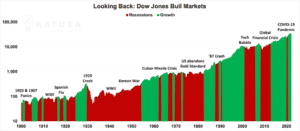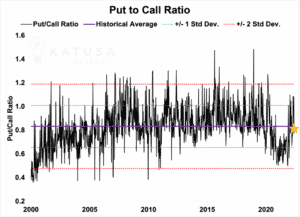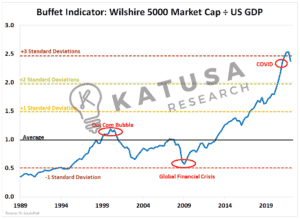
Stock market valuations are consistently in limbo.They’re either too high or they’re too low.Rarely if ever are markets priced “just right”.With all the uncertainty in the world today, let’s take a deep dive into the current market internals.As the chart below shows, despite the brief blip resulting from the COVID-19 pandemic, the stock markets have since gone right back to business as usual.

At the same time, however, there’s still a general feeling of unease in the air.Among the unease, you have war in Ukraine, food supply issues, and high inflation all casting their shadows over the economy.This makes it a great time to revisit some of our favorite market valuation charts. After all, the data never lies.
1. S&P 500 Price/Earnings Ratio
The first chart we’ll look at is a valuation analysis.It’s the historical performance of the S&P 500 compared to the 1 year forward Price/Earnings ratios of its constituent companies.The P/E ratio compares the price (the market valuation) of a company to its actual earnings.
- The higher the ratio, the more overvalued the company.
- The lower the ratio, the more undervalued it is.

The overall market selloff early this year did impact the S&P 500, which is now down 13% from its all-time high set at the end of last year.
- P/E ratios have fallen as a result. And the current average forward P/E ratio for the S&P 500 is 16.7x.
Over the past 25 years, this ratio has averaged 15.6x through the various bull and bear markets.Given that the current ratio of 16.7x is still higher than the historical average, that would suggest that the S&P 500 is overvalued when compared to the historical trend.
2. Put to Call Ratio
The next indicator is the Put to Call ratio.Simply put, the ratio compares the number of Put options purchased by traders on the derivatives markets to the number of Call options purchased.
- When more Puts are being purchased than Calls, the ratio is greater than one. And there are more traders with a negative outlook on the markets.
- When there are more Calls being purchased, the ratio is lower than one. And there are more traders with a positive outlook on the markets.
Below is a chart of the Put to Call ratio going back to 2000…

Note that the historical average (purple line) is actually 0.83 – which is lower than 1.
- In other words, historically speaking, traders tend to have an optimistic forecast for market performance.
This makes sense, as most analysts believe we have yet to reach peak global economic growth.Over the past several months, the Put/Call ratio has hovered between its historical average and one standard deviation above the mean.This pessimistic position taken by traders matches the negative performance of the markets in the same period.Recently, however, the Put/Call ratio has pulled back to 0.81, as indicated by the gold star at the end of the chart – which is just under the historical average.
- This means that traders are just starting to feel optimistic about the markets again.
3. The Buffett Indicator
This indicator comes straight from the Oracle of Omaha himself, Warren Buffett.He once claimed this indicator to be “probably the best single measure of where valuations stand at any given moment” in a December 2001 article in Fortune magazine.Buffett has since acknowledged the limitations of the indicator, given its simplicity.Still, it remains a very popular market indicator, particularly for the U.S. markets.The Buffett Indicator is very straightforward…
- It’s simply the ratio of total U.S. stock market capitalization (represented by the Wilshire 5000 index) to U.S. GDP.
Ever since the Global Financial Crisis of 2008, when the Buffett Indicator dipped below 60%, the indicator has consistently stayed well above 100%.While the outbreak COVID-19 pandemic saw the indicator drop back to the 100% mark, it shot right back up to over 200% at the end of 2021 – right before the big market selloff saw the indicator drop back to near pre-pandemic levels.Below is a chart that shows the indicator back to its initial construction back in 1971.

As you can see, the Buffett Indicator has historically continued to trend upwards.This means that investors are consistently looking further into the future and pricing in more “blue sky potential”.After the mega stimulus packages post-pandemic, this pushed the ratio to all-time highs, and for the mathletes a +3 standard deviation move.Right now, with the indicator well above pre-pandemic levels, it is suggesting that investors are still looking through rose-colored glasses and awarding big premiums to equities.If investors were truly fearful today, the indicator is at or below pandemic levels.
4. Volatility Traders are Salivating
After years of slumber, the volatility trade is back in full force.War in Europe, rising interest rates, inflationary concerns, and stagnating economic growth are all music to the ears of bears and volatility traders.The volatility index is a gauge created through S&P 500 option pricing expectations over the next 30 days.
- When uncertainty is elevated, premiums for options increase which leads to an increase in the Volatility Index (VIX).
You can see the massive spike in March 2020 when COVID rocked the world. Global stimulus packages reduced uncertainty as the Fed had the back of the markets, and thus crushed volatility.Now with interest rates rising and the Fed taking its foot off the stimulus gas pedal, uncertainty is back.Below is a chart which shows the VIX over the past 5 years.

Putting It All Together
There is no crystal ball for the stock market.To anyone who thinks they’ve got it figured out, I wish them luck and will send you the documents for the next bridge purchase.The market is ever-evolving and changes instantaneously and right now, there’s a lot of uncertainty in the world.It is a trillion-dollar game of cat and mouse.Now is the time to revisit your portfolio’s shopping list to figure out which investments are still worth your dollar.Or you can have the shopping list provided to you.At Katusa Research, all my subscribers know my thoughts on the market, and where I’m putting my investment dollars to work. As a fund manager for 25+ years, I’ve learned the hard lessons in tough bear markets.I’ve got my wish list handy, and I already know what price I’d be willing to pay for each company on it.At Katusa’s Resource Opportunities, you’ll be able to see exactly which moves I’m looking to make – with the exact analysis I use to make the decision.Regards,Marin Katusa
Big Ideas We’re Covering Now
Get up to speed on where Marin sees huge opportunities. Below are the most important trends and opportunities we’re tracking right now.
Before You Buy ANY Oil Stocks, READ THIS
Love it or hate it, oil is a lifeline to international trade. In turn, it provided incredible economic growth and investment opportunities around the world. Full details on this link here.
Market Signals: Cash, Buffett, and Gold
Volatility traders are pricing in more risk, and many are turning to cash. Full details on this link here.
Tesla Carbon Credit Sales Jump by 116%
Tesla beat 1st quarter income expectations with more than double previous quarters’ carbon credit sales. Full details on this link here.
The Rise of America
Get your copy of Marin Katusa’s new book The Rise of America at Amazon Canada here or Amazon US here. And also in Barnes & Noble or any retail book store near you.










